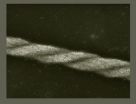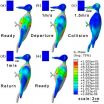(Press-News.org) Nanocubes are anything but child's play. Weizmann Institute scientists have used them to create surprisingly yarn-like strands: They showed that given the right conditions, cube-shaped nanoparticles are able to align into winding helical structures. Their results, which reveal how nanomaterials can self-assemble into unexpectedly beautiful and complex structures, were recently published in Science.
Dr. Rafal Klajn and postdoctoral fellow Dr. Gurvinder Singh of the Institute's Organic Chemistry Department used nanocubes of an iron oxide material called magnetite. As the name implies, this material is naturally magnetic: It is found all over the place, including inside bacteria that use it to sense the Earth's magnetic field.
Magnetism is just one of the forces acting on the nanoparticles. Together with the research group of Prof. Petr Král of the University of Illinois, Chicago, Klajn and Singh developed theoretical models to understand how the various forces could push and pull the tiny bits of magnetite into different formations. "Different types of forces compel the nanoparticles to align in different ways," says Klajn. "These can compete with one another; so the idea is to find the balance of competing forces that can induce the self-assembly of the particles into novel materials." The models suggested that the shape of the nanoparticles is important – only cubes would provide a proper balance of forces required for pulling together into helical formations.
The researchers found that the two main competing forces are magnetism and the van der Waals force. Magnetism causes the magnetic particles to both attract and repel one another, prompting the cubic particles to align at their corners. Van der Waals forces, on the other hand, pull the sides of the cubes closer together, coaxing them to line up in a row. When these forces act together on the tiny cubes, the result is the step-like alignment that produces helical structures.
In their experiments, the scientists exposed relatively high concentrations of magnetite nanocubes placed in a solution to a magnetic field. The long, rope-like helical chains they obtained after the solution was evaporated were surprisingly uniform. They repeated the experiment with nanoparticles of other shapes but, as predicted, only cubes had just the right physical shape to align in a helix. Klajn and Singh also found that they could get chiral strands – all wound in the same direction – with very high particle concentrations in which a number of strands assembled closely together. Apparently the competing forces can "take into consideration" the most efficient way to pack the strands into the space.
Although the nanocube strands look nice enough to knit, Klajn says it is too soon to begin thinking of commercial applications. The immediate value of the work, he says, is that it has proven a fundamental principle of nanoscale self-assembly. "Although magnetite has been well-studied – also its nanoparticle form – for many decades, no one has observed these structures before," says Klajn. "Only once we understand how the various physical forces act on nanoparticles can we begin to apply the insights to such goals as the fabrication of previously unknown, self-assembled materials."
INFORMATION:
Dr. Rafal Klajn's research is supported by the Abramson Family Center for Young Scientists; the estate of Olga Klein Astrachan; and the European Research Council.
The Weizmann Institute of Science in Rehovot, Israel, is one of the world's top-ranking multidisciplinary research institutions. Noted for its wide-ranging exploration of the natural and exact sciences, the Institute is home to scientists, students, technicians and supporting staff. Institute research efforts include the search for new ways of fighting disease and hunger, examining leading questions in mathematics and computer science, probing the physics of matter and the universe, creating novel materials and developing new strategies for protecting the environment.
Weizmann Institute news releases are posted on the World Wide Web at http://wis-wander.weizmann.ac.il, and are also available at http://www.eurekalert.org.
Nanocubes get in a twist
2014-08-11
ELSE PRESS RELEASES FROM THIS DATE:
How the woodpecker avoids brain injury despite high-speed impacts via optimal anti-shock body structure
2014-08-11
Designing structures and devices that protect the body from shock and vibrations during high-velocity impacts is a universal challenge.
Scientists and engineers focusing on this challenge might make advances by studying the unique morphology of the woodpecker, whose body functions as an excellent anti-shock structure.
The woodpecker's brain can withstand repeated collisions and deceleration of 1200 g during rapid pecking. This anti-shock feature relates to the woodpecker's unique morphology and ability to absorb impact energy. Using computed tomography and the construction ...
Megascale icebergs run aground
2014-08-11
Scientists from the Alfred Wegener Institute, Helmholtz Centre for Polar and Marine Research (AWI) have found between Greenland and Spitsbergen the scours left behind on the sea bed by gigantic icebergs. The five lineaments, at a depth of 1,200 metres, are the lowest-lying iceberg scours yet to be found on the Arctic sea floor. This finding provides new understanding of the dynamics of the Ice Age and the extent of the Arctic ice sheet thousands of years ago. In addition, the researchers could draw conclusions about the export of fresh water from the Arctic into the ...
Western Wall weathering: Extreme erosion explained
2014-08-11
Visitors to the Western Wall in Jerusalem can see that some of its stones are extremely eroded. This is good news for people placing prayer notes in the wall's cracks and crevices, but presents a problem for engineers concerned about the structure's stability.
The Western Wall is a remnant of the ancient wall that surrounded the courtyard of the Jewish Temple in Jerusalem. It is located in Jerusalem's Old City at the foot of the Temple Mount.
To calculate the erosion in the different kinds of limestone that make up the Western Wall, researchers from the Hebrew University ...
Celebrity promotion of charities 'is largely ineffective,' says research
2014-08-11
Celebrity promotion of charities is ineffective at raising awareness, but can make the stars more popular with the public, new research says.
According to journal articles by three UK academics, "the ability of celebrity and advocacy to reach people is limited" and celebrities are "generally ineffective" at encouraging people to care about "distant suffering".
The research, by Professor Dan Brockington, of The University of Manchester, Professor Spensor Henson, University of Sussex, and Dr Martin Scott, University of East Anglia, is published at time when many celebrities ...
A new cause of osteoarthritis identified by research on a rare disease
2014-08-11
A new mechanism of joint destruction caused by a natural material that grinds away healthy cartilage and worsens osteoarthritis has been identified in human hip joints for the first time by University of Liverpool scientists.
The scientists, with Professor Alan Boyde and colleagues from Queen Mary University of London, were studying the hip of a man with the genetic condition, alkaptonuria (AKU), This is a metabolic disease in which a substance called homogentisic acid accumulates in joint cartilage, causing changes to its physical properties.
The study revealed ...
Challenges and strategies for women pursuing STEM careers
2014-08-11
As a national push continues to recruit talented girls and young women into math and science-related careers, a new study underlines the importance of mentoring and other social support systems for women pursuing those research professions. Mary Jean Amon, a doctoral student in the University of Cincinnati's psychology program, will present her findings at the annual convention of the American Psychological Association in Washington, D.C.
Amon's study uncovered three themes that emerged as women examined the effects of gender stereotypes in STEM fields: career strategies, ...
Sensitive acid sensor controls insulin production
2014-08-11
This news release is available in German. Many human metabolic functions only run smoothly if the acid level in the body remains neutral and stable. For humans, normal blood pH values lie between 7.35 and 7.45. By way of comparison, an empty stomach is extremely acidic, with a pH value of 1.5.
The body constantly monitors this narrow pH band and quickly restores the ideal pH values in the event of any deviations. This is because many proteins cease to function properly if fluids in the body become even slightly more acidic. These proteins become unstable and alter ...
Testosterone in healthy men increases their brains' response to threat
2014-08-11
Philadelphia, PA, August 11, 2014 – Testosterone, a steroid hormone, is well known to contribute to aggressive behavior in males, but the neural circuits through which testosterone exerts these effects have not been clear.
Prior studies found that the administration of a single dose of testosterone influenced brain circuit function. Surprisingly, however, these studies were conducted exclusively in women.
Researchers, led by Dr. Justin Carré, sought to rectify this gap by conducting a study of the effects of testosterone on the brain's response to threat cues in healthy ...
Emergency gallbladder surgery: do you need it, or can you afford to wait?
2014-08-11
Rochester, Minn. — Gallstone pain is one of the most common reasons patients visit emergency rooms. Figuring out who needs emergency gallbladder removal and who can go home and schedule surgery at their convenience is sometimes a tricky question, and it isn't always answered correctly. A new Mayo Clinic study found that 1 in 5 patients who went to the emergency room with gallbladder pain and were sent home to schedule surgery returned to the ER within 30 days needing emergency gallbladder removal. The surgical complication rate rises with the time lag before surgery, the ...
New global research reveals most adults need to double fruit and vegetable intake
2014-08-11
New research published in the September issue of the British Journal of Nutrition and featured in the just released Global Phytonutrient Report highlights a significant shortfall in fruit and vegetable consumption in people's diets around the world. Commissioned by the Nutrilite Health Institute of Amway, the research finds the majority of adults worldwide would have to at least double their current consumption of fruits and vegetables to meet the World Health Organization's minimum recommendation of five servings (400 grams) per day. Additionally, the vast majority of ...


